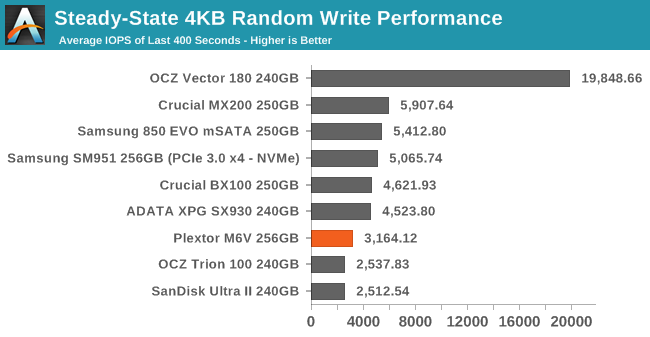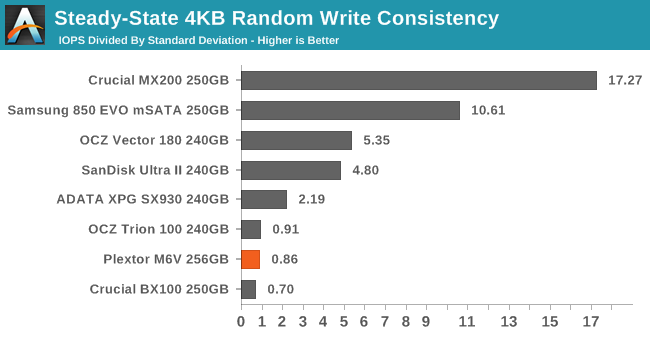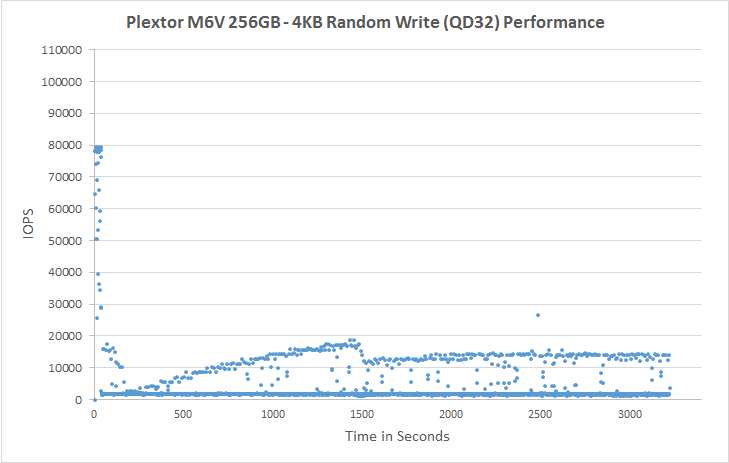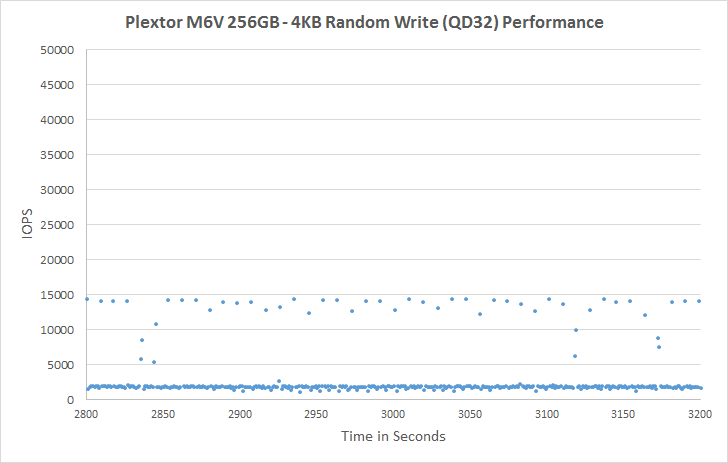The Plextor M6V (256GB) SSD Review
by Billy Tallis on October 12, 2015 8:00 AM ESTPerformance Consistency
Our performance consistency test saturates the drive with 4kB random writes for a full hour, with a queue depth of 32, the maximum supported by the AHCI protocol used by SATA and most PCIe drives. This puts the drive's controller under maximum stress and writes enough data to exhaust all free space and spare area on the drive. This is an unrealistic workload for any client use, but it provides a worst-case scenario for long-term heavy use, and it sheds light on how different SSD controllers behave and if their performance will hold up as they fill up.
The average of the last 400 seconds of the test gives us a steady-state IOPS rating that is usually very different from what the manufacturer specifies for a new, empty drive. We also quantify the consistency of the drive's random write performance, and provide plots of the performance over the course of the test.

The M6V's steady-state performance falls well behind the Crucial BX100 and only slightly ahead of drives using TLC NAND, pointing to either significant firmware differences or lower performance from the Toshiba 15nm MLC than Micron's 16nm MLC.

Plextor is able to eke out a little more consistency from the SM2246EN, but unfortunately this is due to the best-case being worse, rather than a significant improvement in the worst-case IOPS.
 |
|||||||||
| Default | |||||||||
Looking at the whole duration of the test, we see that once the M6V is filled and performance takes a nosedive, the M6V has a very slow recovery toward its steady state of occasionally reaching around 15k IOPS. Like the BX100, it has a pretty solid baseline and there are no garbage-collection pauses that drop it in to hard drive territory.
 |
|||||||||
| Default | |||||||||










51 Comments
View All Comments
eek2121 - Tuesday, October 13, 2015 - link
PCIE SSDs? Can you find me one with 500 gb storage for $169? The market isn't there yet. PCIE SSDs are in the minority and the price premium is still too high. The performance difference is minimal, especially for casual users.Denithor - Tuesday, October 13, 2015 - link
How's $173? Amazon has the Crucial MX200 500GB drive at this price point. And if you had asked yesterday, it was on sale for $140.http://www.amazon.com/Crucial-MX200-500GB-Internal...
coolhardware - Tuesday, October 13, 2015 - link
I believe he was referring to any type of PCIe SSDs such as http://amzn.to/1Naj0E2 (Intel 400GB) or a M.2 drive, not a SATA drive as per your link (Crucial 500GB).Luke212 - Tuesday, October 13, 2015 - link
You mean in your circumstances. Most laptops dont support M.2 PCIe. So we are stuck buying M.2 Sata or 2.5" Sata.SmokingCrop - Tuesday, October 13, 2015 - link
HDD is too slow for OS/programs and PCIe is too expensive.SATA SSD's is the sweet spot in between.
usernametaken76 - Thursday, October 15, 2015 - link
Some people have older systems and would like to freshen them without replacing the thing, you know? Not everyone can utilize PCIe storage (laptops for instance) and not everyone wants the drawbacks of spinning HDD storage. That's the nice thing about choice, dj_aris doesn't get to make the choice for everyone.Denithor - Monday, October 12, 2015 - link
And today only (10/12) the Crucial BX100 250GB drive is on sale at Amazon for $64. So this could make the whole question of best value for price moot, if you move quickly.:)
coolhardware - Tuesday, October 13, 2015 - link
Ordered one myself! Currently Amazon's #1 selling SSD. http://amzn.to/1VPK7vk The 500GB drives are a nice price too.Just imagine, in a few years we should be able to get 2TB and 4TB+ for a fairly low price. That will be AWESOME.
nmm - Monday, October 12, 2015 - link
I guess I can understand the compulsion to build a better SATA SSD if you're not already the market leader in SATA SSD's. It's much cheaper than plunging into uncharted territory. I do find it a little puzzling that there isn't more movement in the M.2/U.2 market. Seems like it would get tiresome constantly bumping up against the limits of the protocol for years on end.Gigaplex - Monday, October 12, 2015 - link
If these lower end SSD manufacturers targeted a faster protocol using tech that can't fully utilise SATA3, it's likely to be an uncompetitive product.